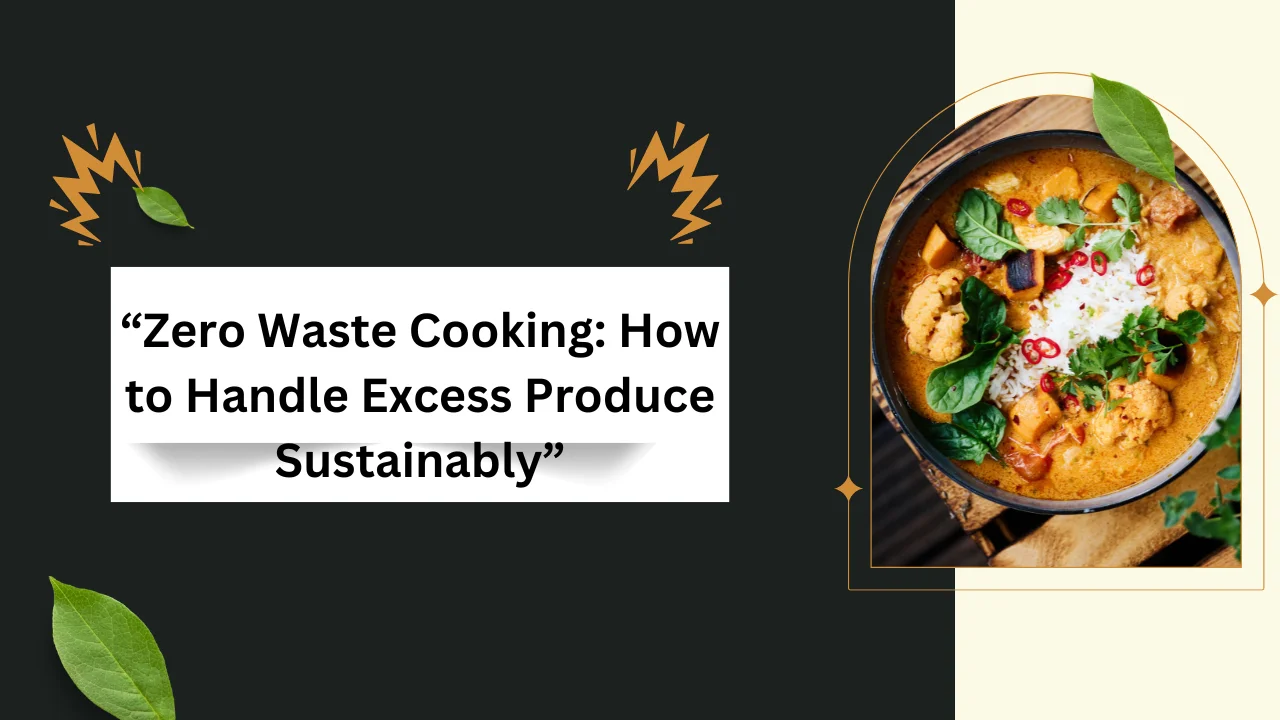In a world where food waste is a significant environmental issue, handling excess produce sustainably has become more crucial than ever. Zero waste cooking focuses on minimizing waste and making the most out of every ingredient, including those surplus fruits and vegetables that often end up in the trash. With a few thoughtful strategies, you can reduce waste, save money, and enjoy delicious meals. Here’s a comprehensive guide on how to manage excess produce sustainably.
1. Plan Ahead to Avoid Surpluses
Effective planning is the first step in managing excess produce:
- Smart Shopping: Buy only what you need based on your meal plan. Consider the shelf life of the produce and adjust your purchases accordingly.
- Seasonal Buying: Purchase seasonal produce in moderation to avoid buying more than you can use. Seasonal fruits and vegetables tend to be fresher and more affordable.
2. Proper Storage Techniques
Proper storage can extend the life of your produce and reduce waste:
- Refrigeration: Store perishable items like berries, leafy greens, and cut vegetables in the refrigerator. Use crisper drawers to maintain optimal humidity levels.
- Room Temperature: Keep items like tomatoes, potatoes, and onions in a cool, dry place. Avoid storing them near each other as some produce, like apples, emit ethylene gas that can speed up ripening.
3. Preserve Produce
Preservation methods are an excellent way to extend the life of excess produce:
- Freezing: Freeze fruits, vegetables, and herbs to use later. Blanch vegetables before freezing to preserve their texture and color.
- Canning: Make jams, sauces, or pickles from excess produce. Home canning can be a fun way to preserve seasonal fruits and vegetables for future use.
- Drying: Dehydrate fruits and vegetables to create snacks or ingredients for future meals. You can use a food dehydrator or an oven for this process.
4. Creative Cooking with Excess Produce
Get inventive in the kitchen to use up excess produce:
- Smoothies and Juices: Blend overripe fruits into smoothies or juices. This is a great way to use up fruit that may not be fresh enough for eating on its own.
- Soups and Stews: Add surplus vegetables to soups and stews. A hearty vegetable soup or a mixed veggie stew is an excellent way to utilize various produce.
- Baking and Cooking: Incorporate fruits and vegetables into baked goods like muffins, bread, and cakes. Carrots, zucchini, and apples work particularly well in baking recipes.
5. Make Homemade Preserves
Homemade preserves can be a great way to use excess produce:
- Fruit Compotes and Chutneys: Cook down excess fruits into compotes or chutneys, which can be stored in jars and used as toppings or sides.
- Vegetable Pickles: Create quick pickles from surplus vegetables. Pickling is a simple way to preserve produce and add flavor to your meals.
6. Compost Scraps and Unused Produce
When you can’t use produce, composting is a sustainable option:
- Composting: Create a compost bin or use a composting service to turn food scraps and inedible parts of produce into nutrient-rich soil.
- Community Composting: If you don’t have space for a compost bin, check if your community offers composting programs or drop-off sites.
7. Share or Donate Excess Produce
Sharing or donating excess produce helps reduce waste and supports those in need:
- Share with Neighbors: Offer surplus produce to friends, family, or neighbors. It’s a great way to build community connections and reduce waste.
- Donate to Food Banks: Many food banks and local charities accept fresh produce. Check with local organizations to see if they accept donations of excess fruits and vegetables.
8. Create a Meal Plan for Surplus Produce
Develop a meal plan specifically to use up excess produce:
- Weekly Menu: Design your weekly menu around the produce you have on hand. Incorporate a variety of dishes to ensure nothing goes to waste.
- Flexible Recipes: Choose recipes that can easily be adapted to include different types of produce. Stir-fries, casseroles, and salads are versatile options.
Conclusion
Handling excess produce sustainably is an integral part of zero waste cooking. By planning your purchases, storing produce properly, using preservation methods, getting creative in the kitchen, and exploring composting and donation options, you can effectively manage surplus produce and reduce waste. Embracing these practices not only benefits the environment but also enhances your culinary skills and contributes to a more sustainable lifestyle. With these strategies, you can turn excess produce into opportunities for delicious and mindful cooking.
